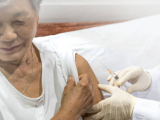The World Health Organization (WHO) today recommended keeping the same strains for the Northern Hemisphere's 2014-15 flu season, based on its advisory group's in-depth analysis of the most recent circulating strains and patterns.
The advisors met in Geneva this week, and their recommendation today involves the same strains recommended for the Southern Hemisphere's upcoming flu season, which typically runs from May through October.
The WHO recommended strains similar to the following for the 2014-15 flu season:
- A/California/7/2009 (H1H1) pdm09
- A/Texas/50/2012 (H3N2)
- B/Massachusetts/2/2012
Also, the WHO recommended an additional strain similar to influenza B/Brisbane/60/2008, of the Victoria lineage, for quadrivalent (four-strain) vaccines, which contain two influenza B viruses. That is also the same as last year's second B strain choice.
Today's announcement allows vaccine companies to start formulating the next season's flu vaccine, a process that takes about 6 months. Strain selection clears the way for the first step—preparing the vaccine viruses and growing them in eggs. WHO typically makes its recommendation for the Northern Hemisphere in February, repeating the process in September for the Southern Hemisphere.
In a technical report that accompanied the recommendations, the WHO said between September and February all seasonal H1N1 viruses detected across the globe were 2009 H1N1, and tests show all are closely related to the current vaccine strain.
For recent H3N2 viruses, tests against reference viruses showed no sign of significant antigenic drift, the agency said.
Though both influenza B lineages circulated, the Yamagata lineage predominated in countries reporting influenza B activity, the WHO said. The B/Massachusetts/2/2012 strain recommended for the trivalent vaccine is of the Yamagata lineage.
Antiviral resistance testing found that most 2009 H1N1 viruses were sensitive to oseltamivir (Tamiflu) and all were sensitive to zanamivir (Relenza). A small number of viruses in China, Japan, and the United States showed resistance to oseltamivir, with a community cluster in Japan that was resistant to both oseltamivir and peramivir.
The WHO said in all instances, those viruses had the H275Y substitution, and in most cases patients had not been treated with antiviral drugs.
National and regional authorities approve the make-up and formulation of vaccines made in each country, and health officials in each country make their own recommendations on the use of flu vaccines, the WHO said.
See also:
Feb 20 WHO strain selection report
Sep 26, 2013, CIDRAP News scan "WHO picks strains for 2014 Southern Hemisphere flu vaccine"





















